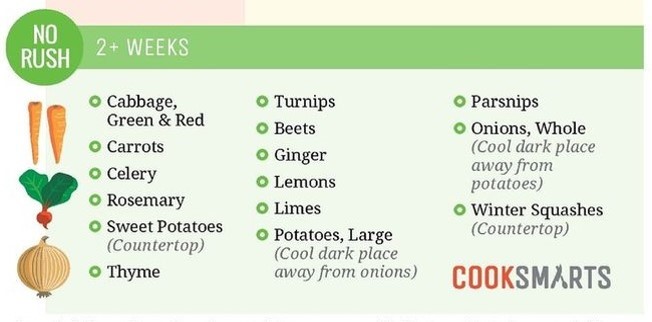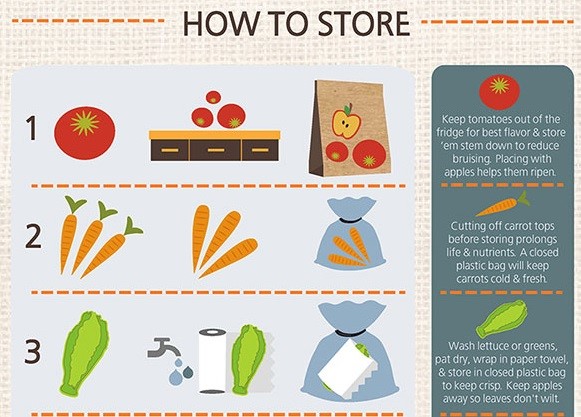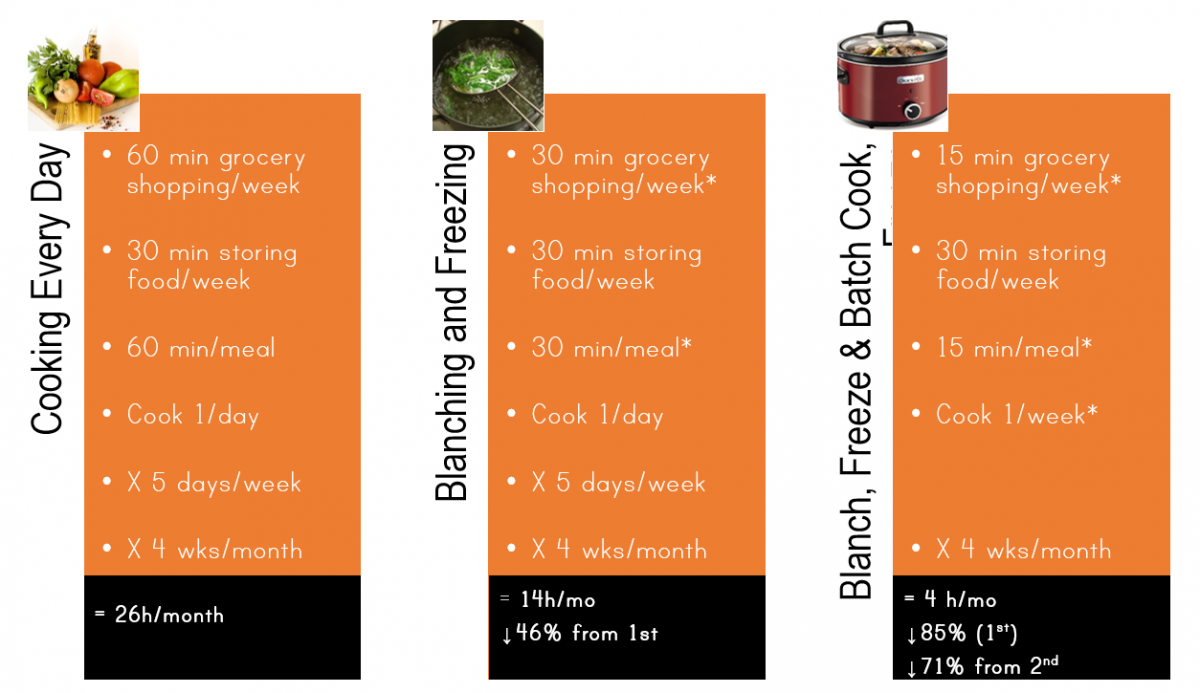How Healthy Eating and Smart Planning Can Free Up Your Time and Increase Your Energy
The end of the year is here, and many of us are starting to think about what changes we want to make for 2016. Many of us also want to make a difference in how we eat, but think that it takes too much time to prepare fresh meals rather than popping “whatever” into the microwave. But the truth is that you can actually transform your meal prep habits, so you can eat healthily while also saving time. And for those doubters out there, still not sure if “eating right” should be at the top of their resolution list, let me start with a story:
A professor stood in front of his class with an empty jar and a bag of rocks. After getting the students’ attention, the professor poured the rocks into the jar. Then, he asked the students if the jar was full. All students said yes. So, he picked up another bag of smaller rocks and throw them into the same jar. The small rocks rolled into the open areas between the bigger rocks. The students laughed, and the professor asked if the jar was now full (for sure). The students agreed that yes, the jar was finally full. Next, the professor picked up a bag of sand and poured it into the jar, where it seeped in between the small and large rocks, while saying: “I want you to recognize that this is your life. The larger rocks are your important things in life – things that are so important, in fact — like your family and your health — that if you lost them you would be affected in a major way. The smaller rocks and the sand are the other small things, like your job and your car. If you try to put the sand or the smaller rocks into the jar first, there is no room for the large rocks.”
In this tale, the professor is basically talking about our priorities in life. In a previous article on SharpHeels, we learned that to change our habits, we need to focus on our energy levels (or health, analogous to the big rocks), rather than specifically on time management (i.e. analogous to the smaller rocks and sand). And in order to get that great energy level, it’s crucial to zero in on healthy eating.
Health should be a priority for everybody. Without health, we live poorly and miserably. But with planning and simple tasks, you can actually save hours each day. This will leave you time to savor delicious, nutritious food that also provides you with that all-important stamina.
Plan Your Meals in 4 Easy Steps
1. Smart Ways to Buy and Store Food
- I have two recommended times for grocery shopping: one is on Friday evening, because this allows you to avoid going out to eat over the weekend. Another one is on Saturday mornings, which is good because you can buy fruits and vegetables to prepare (see below) for the following week.
- You may also purchase your produce online – it’s a great, convenient option to have your food delivered to your door. There are many companies that do this, like Prime Pantry Amazon, Peapod, Instacart, or Local Harvest. In addition, there are a few companies like Blue Apron, Hello Fresh, and Plated that deliver pre-portioned food items to use in a recipe they send you for that day or for several meals.
- Next, buy lasting fruits and vegetables – in other words, try to purchase produce that won’t go bad easily, in case you take a while to decide to cook them. Usually, “root” vegetables, such as yams, potatoes, and radishes, last a longer time. The picture below, from cooksmarts.com, shows examples of other vegetables that last longer.

- Also, the way you store your produce will have an impact on its freshness and life cycle. Fox example, tomatoes are better stored on a countertop, and leafy greens can be washed and patted dry, then stored wrapped in a paper towel and in a closed plastic bag away from fruits like apples that release ethylene gas. (The picture below, illustrating some of these tips, is from a Chicago company called Door To Door Organics that delivers exactly that.)

- The next technique is to buy peeled, pre-washed, pre-cut fruits and vegetables to save you prep time. Bonus: if you have them handy in the house, you’re more likely to eat them often.
- Also, you can buy frozen, canned or microwave food options as well. There are many BPA-free canned options to consider, and ways to avoid BPA when microwaving (BPA is a chemical harmful to our bodies).
- Also, read up on nutrition facts by checking the ingredients label. For example, if you’re buying frozen mangoes, it should ideally only list “frozen mangoes” on the ingredient list, without chemicals.
- If you are buying a canned food, where salt is used as a preservation method, you will need to check the sodium content and choose a brand with the lowest amount.
2. Time-Saving Pre-Preparation Tips
- Now that you have your food, you can perform a technique called blanching and freezing. Blanching, which generally takes 2-4 minutes depending on the vegetable, is a great pre-preparation technique for when you want to freeze fruits and veggies for later use while keeping their nutritional value and freshness for up to six months.
Fruits: This technique works best on fruits with a consistency similar to that of an apple; fruits like pineapple or papaya are too soft, and this technique does not work for them.
Veggies: You can blanch a large variety of vegetables, leafy and non-leafy ones.
Here is the process:
1. Wash the fruits or vegetables well. If needed, remove any skin, seeds, or any other non-edible bits. Then cut up what remains into small pieces. For potatoes, it’s best to cut them into strips.
2. Create an ice bath by putting water into a container with ice. Set the container aside for now.
3. Bring water — more than enough to cover your fruits or vegetables completely — to a boil in a saucepan.
4. In the saucepan water, add a few drops of lime juice to stop enzyme action and consequent oxidation of fruits. For vegetables, you may also add a pinch of salt (no more!).
5. When the water starts to boil, add about 1 cup of the fruit or vegetable, and let it sit for 2-5 minutes, depending on the firmness of the food (2 minutes for softer fruits like pears, and 3 for apples, or check the chart with boiling times for different vegetables below). Note: you may save and freeze the water you boiled your vegetables to use for soups and sauces later. Better yet, use it to water your plants.
6. Remove and place the fruit or vegetable into the container ice bath for 2-3 minutes.
7. Remove the fruit or vegetable with a strainer, and pat it dry with a paper towel.
8. Place the food into BPA-free reusable storage bags, such as Saran Wrap or Ziploc, while removing as much of the air as possible. Keep secure with a rubber band if needed. (Note: if you don’t want large pieces of frozen vegetables stuck together, first put the pieces in the freezer separately. About an hour later when they are firm, you can put them together in storage bags.)
9. Then write or place a label on the bag with its expiration date, which is 3 months after that day for fruits, and 6 months for vegetables.
10.When you’re ready to use them, you just put them directly into your blender, saucepan, or Crock-Pot® — no need to thaw them before cooking.
3. Time-Saving, Nutritious Cooking
- You can use your blanched, frozen vegetables in so many ways for dinners. You can also use a food processor to cut up onions, garlic and herbs and save time. Then you can use a Crock-Pot® to do the rest of the work for you. A Crock-Pot® is a slow cooker where you are able to walk away from the preparation of your meal and not think about it for hours.
- Also, remember to eat a fast, easily-made breakfast. To do this, if you don’t have one yet, get a blender. Sure, you can have coffee, whole wheat toast with cheese and fruit, or an egg, etc., but making a smoothie with fruits and vegetables and a source of protein is a great healthy fast breakfast for you.
5 Steps for a Good Blender Recipe:
1. Choose a portion of fruit and/or veggie.
2. Then add a liquid – i.e. juice, milk, tea, or coffee.
3. Next, thicken it with nut butter, yogurt, chia seeds, psyllium, or beans.
4. Throw in some flavor via vanilla extract, dates, herbs, and/or spices.
5. Lastly, add an unsweetened protein powder, spirulina powder or cocoa for a superfood boost.
- Make a fast dinner out of a super-healthy salad by adding whole grains, beans, leafy vegetables, non-leafy vegetables, seeds, herbs and a source of complete protein like tofu, tuna, or chicken. You can also add a condiment like black pepper or oregano and make a healthy dressing by using lime or lemon juice, vinegar, olive oil, or orange juice.
4. Assembling
- Now let’s talk about how to assemble your batch cooking or other foods you cooked – say, in your slow-cooker — for the following week. In fact, you can keep them frozen for up to 2-3 months, and still avoid contamination and spoilage. (There are, however, some foods that do not freeze well, like lettuce, cucumber, radishes, eggs, and cheese.)
- Or you can assemble meals for the week and place them in your fridge, in the back where it is coldest. Make sure you buy BPA-free containers to store them.
With all these tips in hand, you should be on your way to saving time and eating healthily. If you don’t believe me, look below: these are charts I created based on my own experience, transitioning from cooking every day, to instead spending smart time on prep and slow-cooker options, with the amount of time I saved listed at the end. (Of course, these statistics will change from person to person depending on many factors, like how many people you have living in your house, or what types of recipes are commonly made.)

So give it a try, and see if you find that by following the steps above, you are now nibbling on hearty, healthy meals that save you time, give you nutrients, and advance your energy levels!
32 Interviewer Interview Prep
Interviewer Interview Prep Impactful Mentees
Impactful Mentees Benefits of a Mentor
Benefits of a Mentor Advice for First-Time Managers
Advice for First-Time Managers Overcoming the 18-month Itch
Overcoming the 18-month Itch Dressing for Your Style
Dressing for Your Style Interview Style Tips
Interview Style Tips Women's Stocking Stuffers
Women's Stocking Stuffers Gift the Busy Traveler
Gift the Busy Traveler Father’s Day Gift Guide
Father’s Day Gift Guide Airport Layover Activities
Airport Layover Activities Traveling & Eating Healthy
Traveling & Eating Healthy Travel Like a Boss Lady
Travel Like a Boss Lady The Dual California Life
The Dual California Life Gifts for Thanksgiving
Gifts for Thanksgiving Summer Reading List
Summer Reading List Top Leisurely Reads
Top Leisurely Reads New Year, New Books
New Year, New Books Life Lessons from a Sitcom
Life Lessons from a Sitcom Oprah, Amy or Amal?
Oprah, Amy or Amal?






